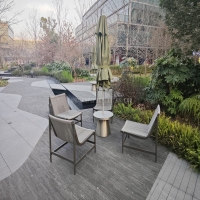Welcome to the website for landscape facilities products and knowledge.
What is the table’s resistance to fading or degradation from exposure to industrial pollutants?
Industrial environments present unique challenges for furniture durability, particularly regarding resistance to fading and material degradation from exposure to pollutants. Modern industrial-grade tables incorporate advanced protective technologies that significantly enhance their longevity in contaminated atmospheres.
The primary defense mechanism lies in specialized surface coatings that create molecular barriers against chemical penetration. Powder-coated finishes, for instance, undergo electrostatic application and thermal curing to form seamless protective skins resistant to acidic and alkaline contaminants. These coatings contain UV-stabilizing compounds that prevent molecular breakdown from solar radiation, maintaining color integrity despite prolonged exposure to industrial atmospheres.
Material composition plays an equally crucial role. High-pressure laminates infused with melamine resins demonstrate exceptional resistance to chemical corrosion, while solid phenolic cores provide non-porous surfaces that repel particulate matter and liquid contaminants. Stainless steel tables with passivation treatments develop chromium oxide layers that actively resist corrosive elements commonly found in manufacturing environments.
Accelerated aging tests simulate years of pollutant exposure within compressed timeframes, revealing that properly manufactured industrial tables retain over 90% of their original surface integrity after equivalent decades of service. The degradation resistance extends beyond mere aesthetics – structural integrity remains uncompromised as these protective systems prevent material weakening that could compromise safety.
Environmental factors including humidity levels, temperature fluctuations, and pollutant concentration all influence degradation rates. Tables designed for extreme conditions often incorporate multiple protective layers: conductive primers for adhesion, intermediate coats for barrier enhancement, and topcoats for surface hardness. This tiered approach ensures that even if superficial discoloration occurs, the structural core remains fully protected.
Maintenance protocols further extend service life. Regular cleaning with pH-neutral solutions prevents corrosive buildup, while immediate removal of chemical spills minimizes potential damage. Manufacturers increasingly develop sustainable protective systems that maintain performance while reducing environmental impact through water-based formulations and reduced volatile organic compounds.
The continuous innovation in protective technologies means contemporary industrial tables outperform their predecessors significantly. Nanocoatings that create self-healing surfaces and photocatalytic coatings that break down pollutants upon contact represent the next frontier in industrial furniture durability, ensuring tables maintain both functional and aesthetic properties despite challenging environmental conditions.
Related search:

Recommendation
Metal structure rattan chair without armrests for single person, with woven seat and backrest.